Happy New Year to all!
As my previous posts outlined, I've been experimenting with a very low-protein, high-carb, low-fat diet. After the holiday season, I’ve fallen pretty far behind on giving updates. In my last post, where I described going somewhat insane experimenting with plantain-based recipes that I could use as staples for such a diet, I was relating events from early December.
I eventually realized that a frozen, ground plantain dough I’d purchased at the supermarket was raw, that I’d been attempting to sub it into recipes that ground plantains after cooking them, and that I wasn’t very smart. I finished up the five-pound bag of plantain dough I’d purchased confirming that.
It was then time, though, to move on to grated cassava recipes!1
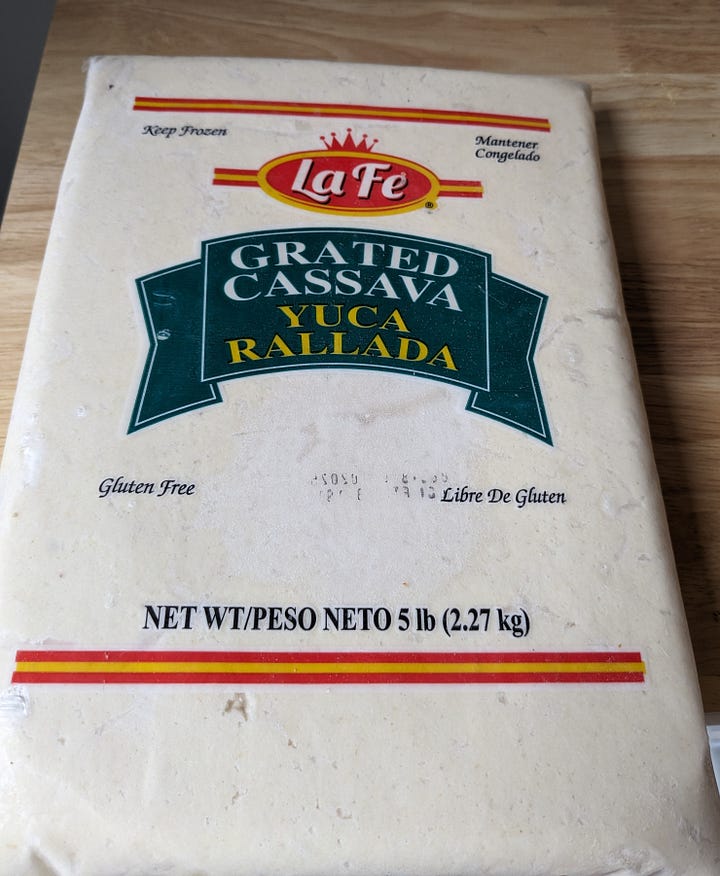
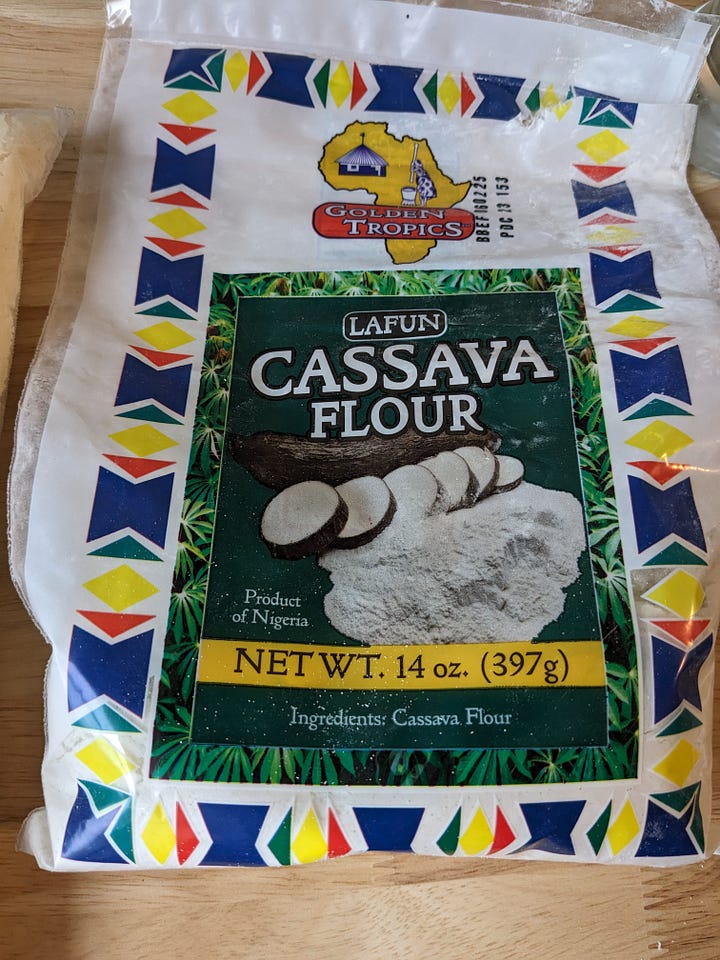
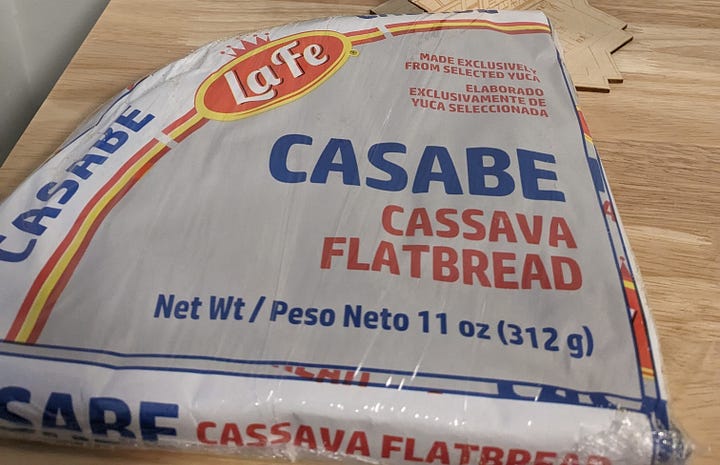
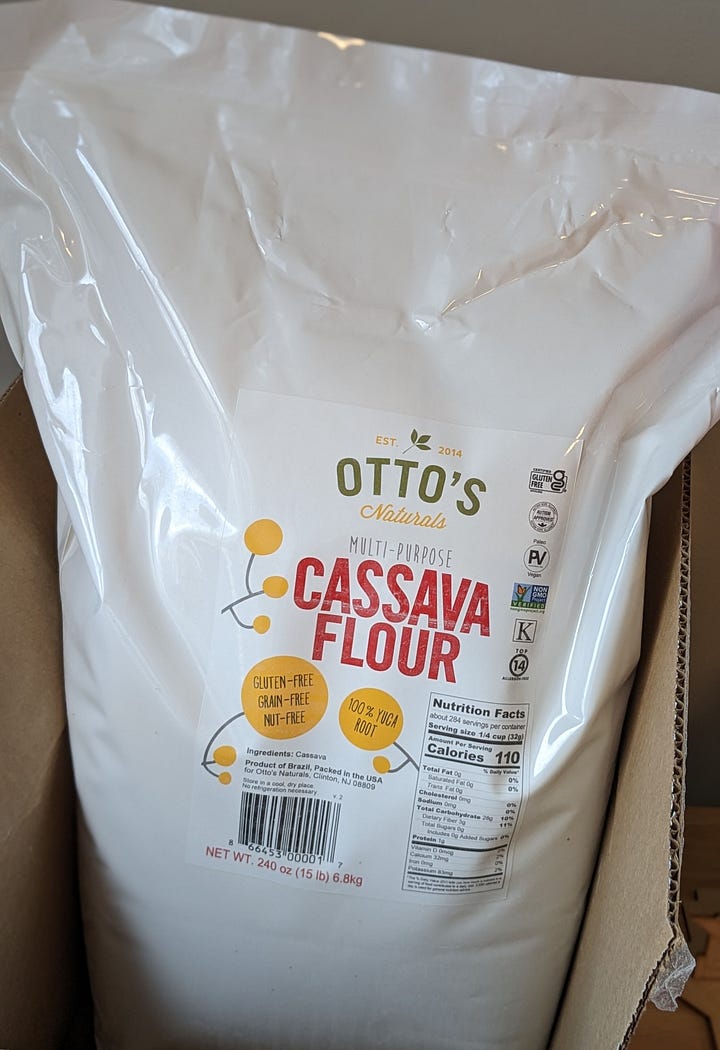
These went much better, although it became clear that if I had reversed the order of these experiments, I could have saved myself a lot of angst.
As I mentioned in my last post, when I Googled for recipes using the bag of frozen green plantain dough, I got approximately nothing. When I googled “uses for frozen grated cassava” I almost immediately found this post, in which someone takes pretty much exactly the approach I landed on with my plantain dough, heats the grated yucca in a pot while stirring it, and gets a usable dough in a few minutes. So if I’d tried working with the frozen cassava first, I’d have had that context and technique already, and probably not have made so many maddeningly poor plantain attempts.
As consolation, I got a recipe that I immediately and easily turned into the first pizza I’d had in a few weeks (since a Thanksgiving weekend cheat).
This article is basically two parts clumsily stapled together; this first one is about weird recipes and such I’ve been trying. Anyone who isn’t doing this diet2 and didn’t enjoy reading about a guy fumbling around with weird starches last time might want to skip down to the “diet updates” heading at the bottom of the article, to see my thoughts on how the Slime Mold Time Mold potato riff results affect our low-BCAA diet hypothesis! For everyone still here…
Cassava Pizza (Take 1)
When I tried this, I had never used cassava for anything but fries before, so I was very interested to see what weird properties it was going to display. I used the “stir cassava for four minutes in a pot with a tablespoon of oil” technique, and the cassava truly just spontaneously became dough. Then I just rolled it out and baked it according to the directions here, although I forgot to add any flour or salt or literally anything else. I know that the lack of salt is a cardinal sin, and it was also weird to add 0 flour, but in my defense I was mystified and relieved that something good appeared to be happening after so much plantain-related suffering.
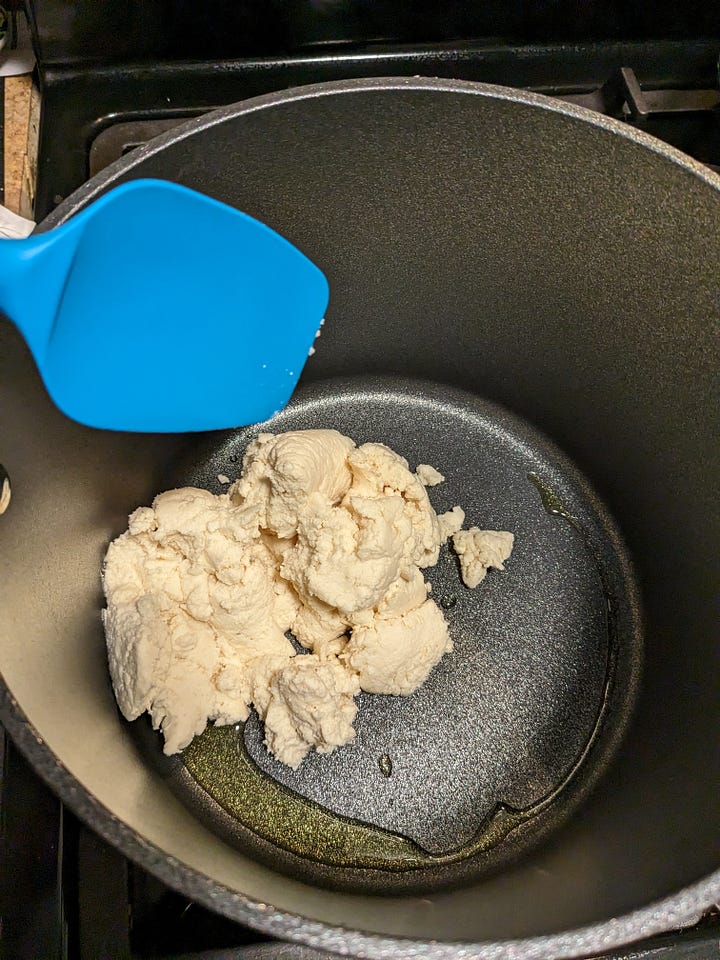
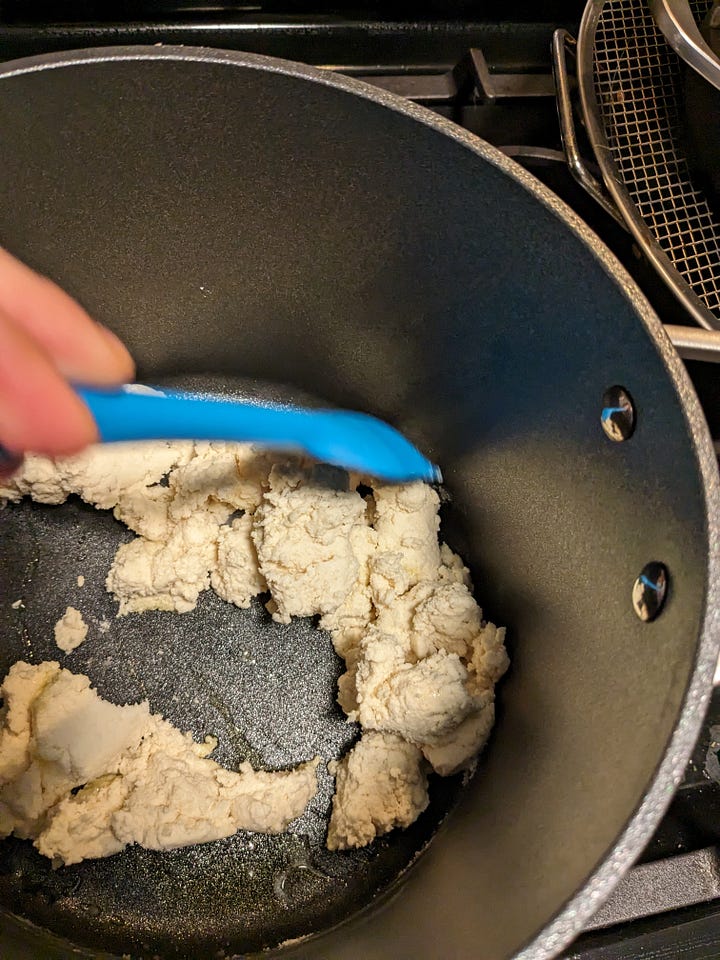
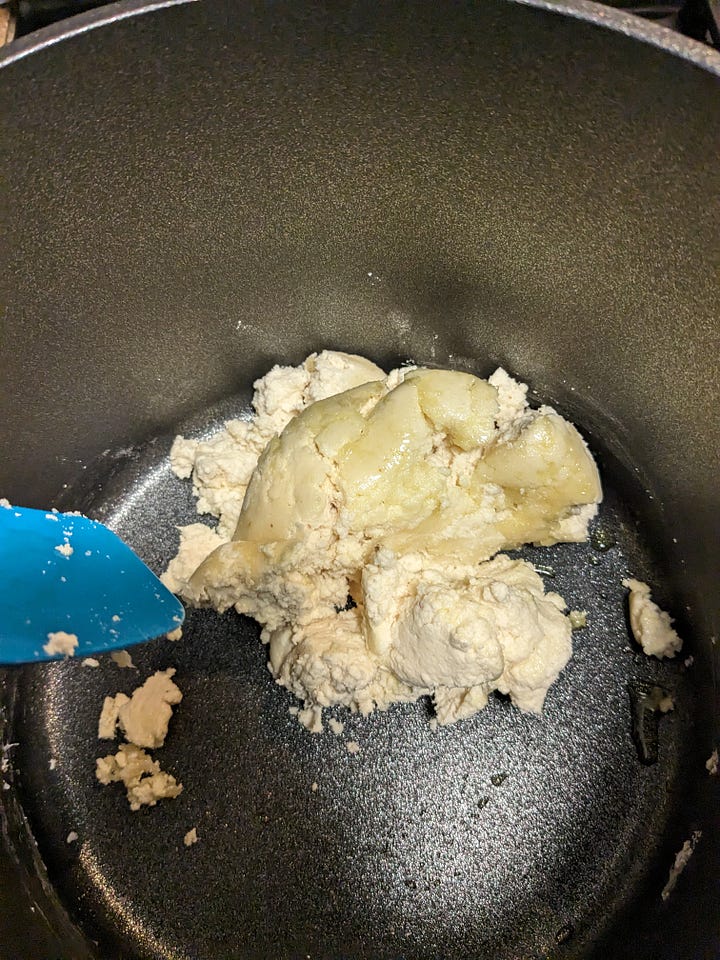
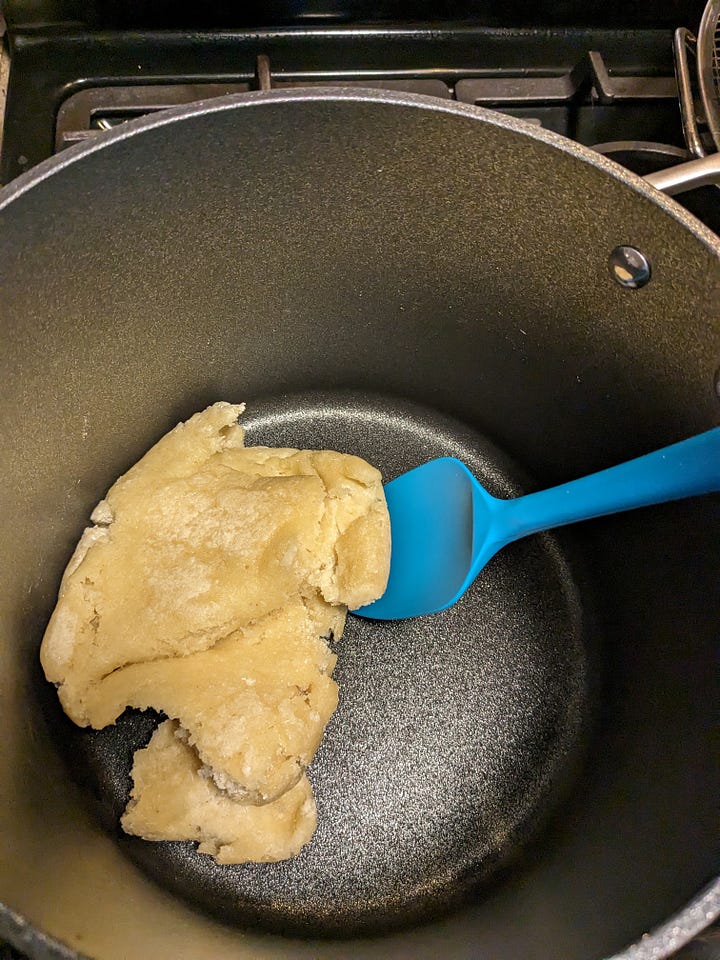
I added a tiny bit more oil and rolled out two small/personal-sized pizza doughs from this with my hands (it wasn’t very hard to form), so apparently 1ish cup of grated cassava is enough to turn into a personal pizza dough. I did notice that some parts had not gone translucent, and when I pulled those out I found they were fibrous root bits not unlike the ones I noticed when I made yuca fries. They were easy to find once the rest was dough, so I just pulled them and threw them out.
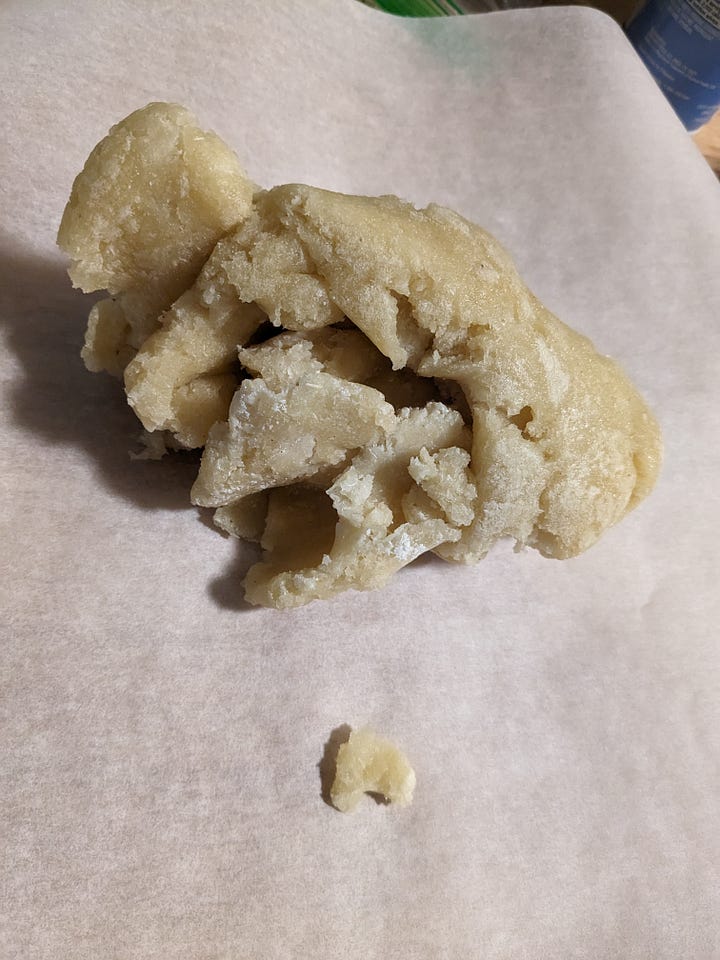
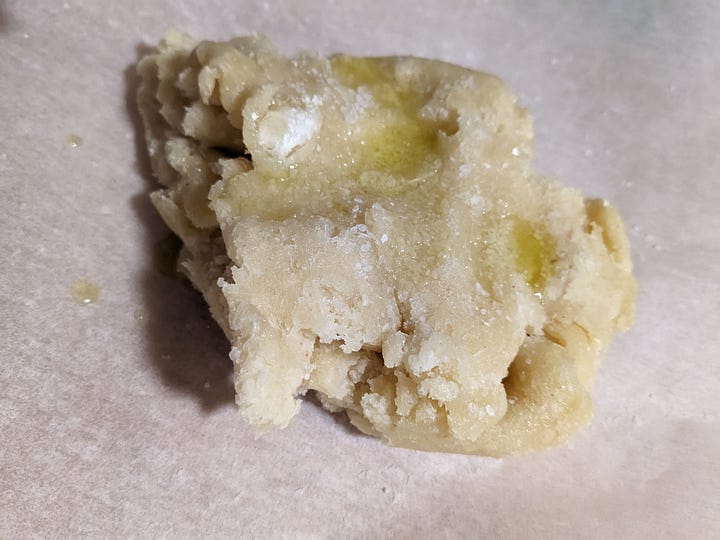
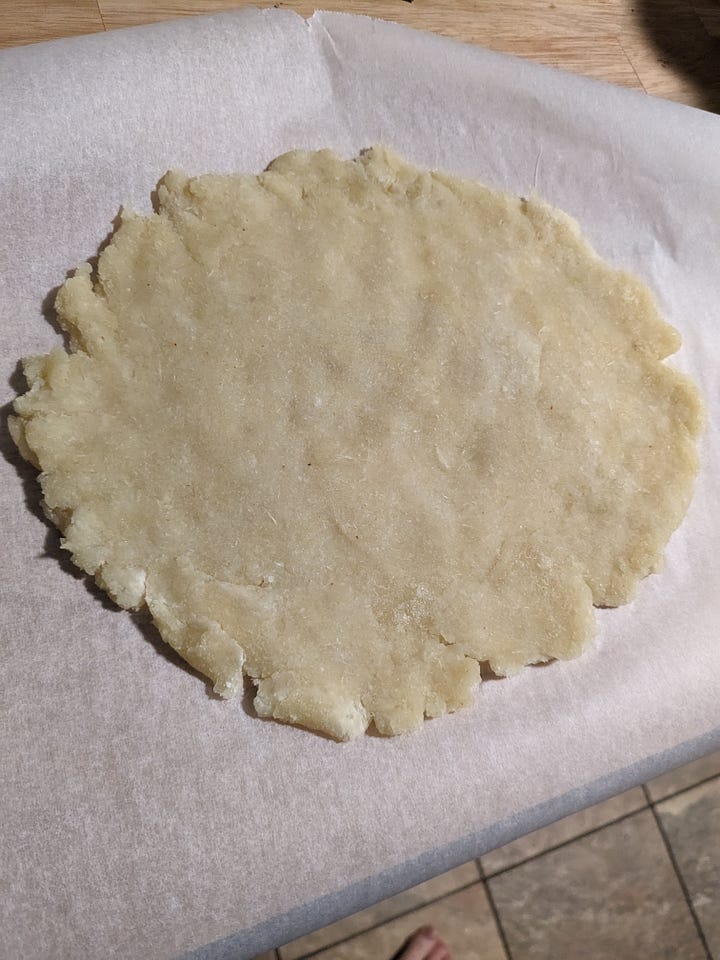

I made a sauce from some fresh cocktail tomatoes I’d been neglecting on account of the sudden and conspicuous lack of sandwiches in my diet. I poured boiling water over them from my electric kettle for a quick blanch, peeled them and cooked them up with some spices.

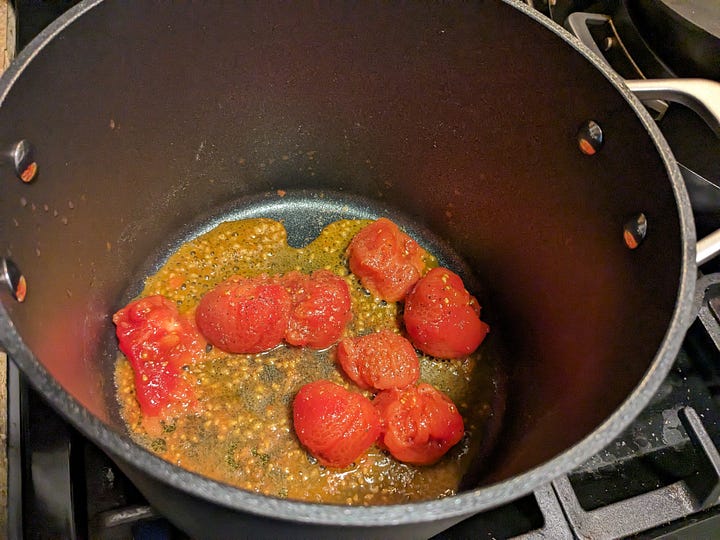

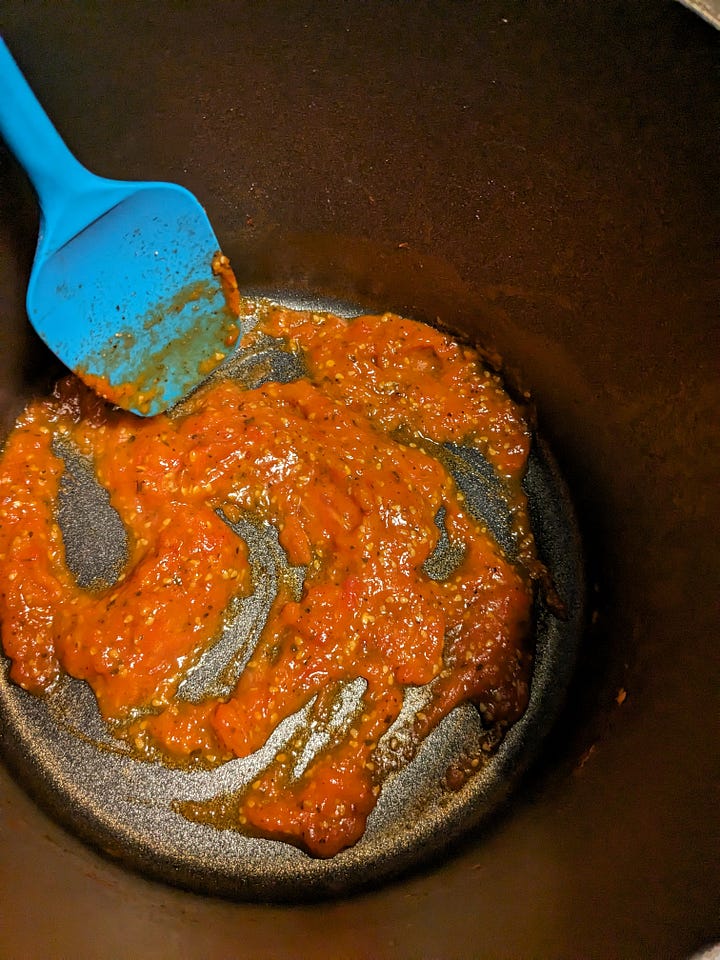
When I flipped my crusts over in the oven, I noticed they weren’t getting very crispy (it was then that I realized I hadn’t used any flour) and so I sprayed them down with coconut oil spray on both sides. I’d do this from the very start for future batches.
When they came out, I added sauce and 2 oz (1/2 cup) of shredded part-skim cheese per pizza, which blew most of my “extra protein” budget for the day and provided most of the fat I’m aiming for, too. From one pizza, I mean.
The pizza crust recipe I was using suggested that cassava doughs would get soggy if sauced too heavily, so I tried to make the sauce pretty thick (I think I added just a bit of gelatin) and used it more sparingly than I might have otherwise. I also decided to make one of the pizzas “half-upside-down”—added 1 oz of cheese, then the sauce, then the other 1 oz of cheese—to see if that would prevent sogginess.

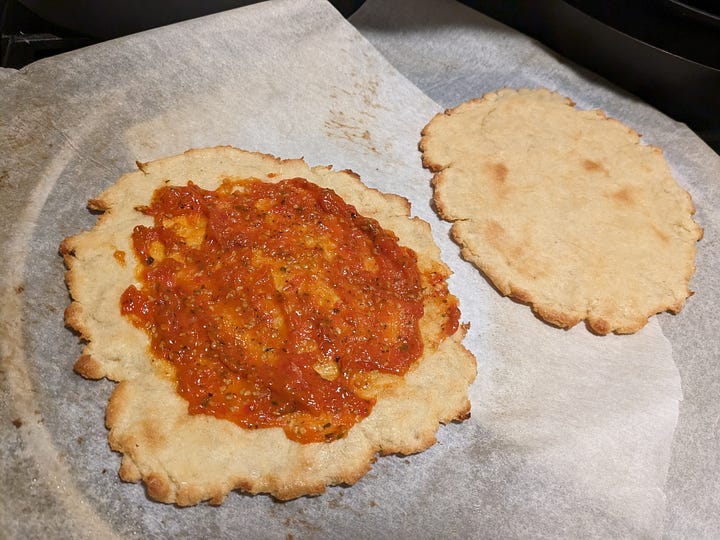
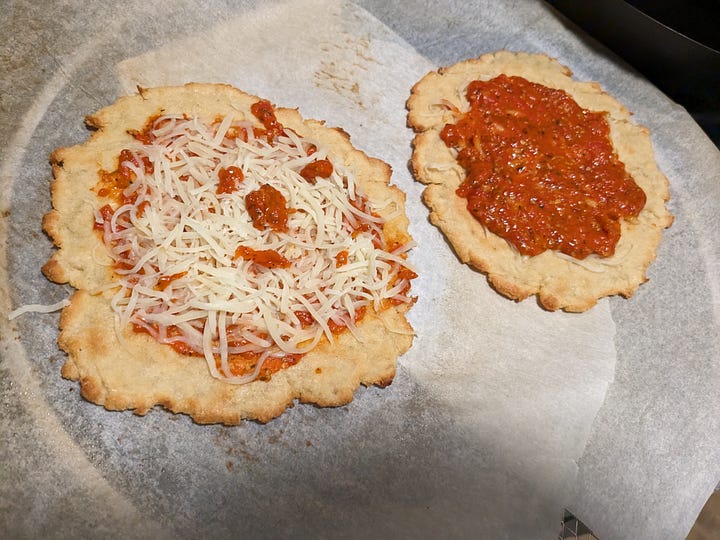
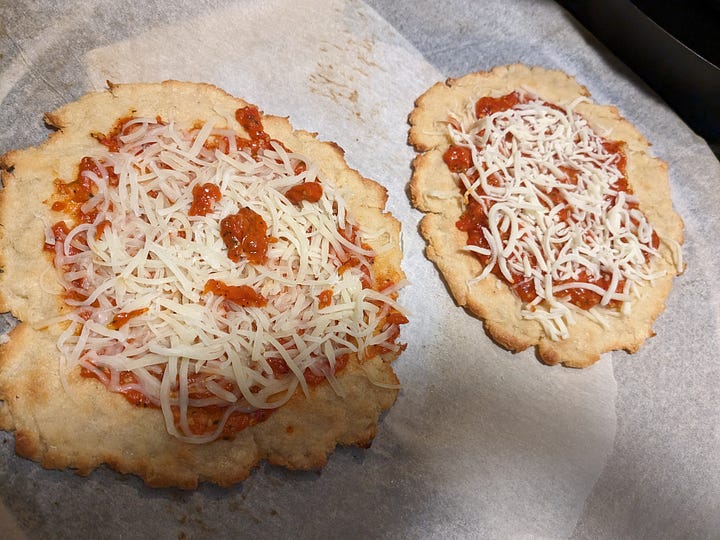
They came out very, very good, for gluten-free pizzas. It’s pretty hard to find gluten-free pizzas with crusts that are at all good, and these were definitely dense, but they were at least as good as any gluten-free frozen pizza I’ve ever tried.3 Given that density, I might try rolling them out thinner next time. The untopped portion of the crusts was very crisp, so in the future I added the toppings so that they came closer to the edge. In a future attempt, I did add flour and didn’t find it much improved. The partly-upside-down one was better, but I’m partial to that style anyway.

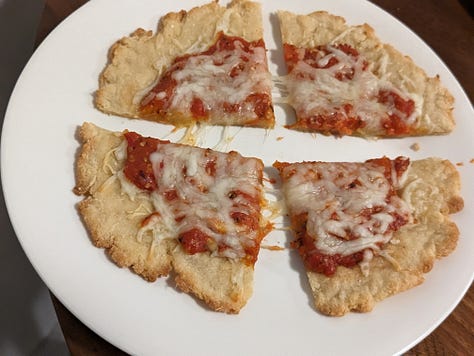
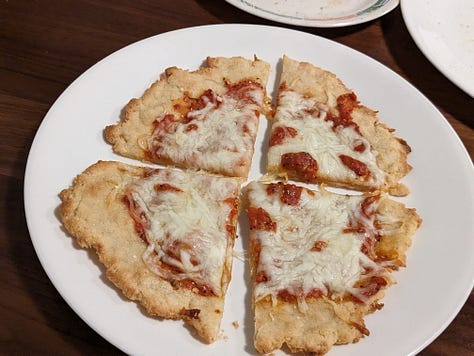
I would recommend trying this out, for anyone doing a protein-restricted diet like this who would nevertheless like to have some pizza. You can theoretically use it for other purposes, too (the linked dough recipe suggests “empanadas, pizza pockets, taco rolls”), but the pizza was so good I haven’t tried it for anything else yet. As a pizza, it pretty much only fits in what I’m estimating the “BCAA budget” is if you’re eating glass noodles and/or cassava pancakes for the rest of the day, or a lot of fruit or what-have-you.
Speaking of cassava pancakes…
Cassava Flour Pancake Trials: Take One
I was initially using store-bought gluten-free pancake mixes for breakfast on this diet, which probably had more protein than I would have aimed for if I was controlling it myself. When I bought my big thing of plantain dough and grated yuca, I also got a small bag of cassava flour from the supermarket. It was a little 14oz sack of it. I decided to try and make this cassava pancake recipe with it.
The recipe’s writer is pretty explicit that different brands’ cassava flours are substantially dissimilar from one another, and that she only uses a few specific (I read as: fancy organic online affiliate link-able) brands that she knows work well.
I ignored this and used my spectacularly cheap Nigerian import grocery store brand to try and make this recipe. Also, I replaced the eggs with gelatin eggs, the “milk or plant milk” with water, sugar, and some heavy cream (calculated to match the macros from regular milk), and reduced the butter.
That didn’t go particularly well.
First, the batter didn’t thicken up at anywhere near the ratios the recipe suggests (I also used gelatin eggs instead of real ones at first, but I did the same with later flours and those still thickened).
The recipe suggested that different brands of cassava flours might need to “hydrate” a bit longer, so I tried their suggestion of slowly adding tablespoon after tablespoon of additional cassava flour while letting this sit for a total of another hour, until I eventually gave up and just cooked them.
The results were poor; the initial bottom side of them would look like a pancake, but the flipped side would look like, for lack of any better way of expressing this, pita. It was a dry crusty edge to the pancake. The inside was gooey, almost custardy.
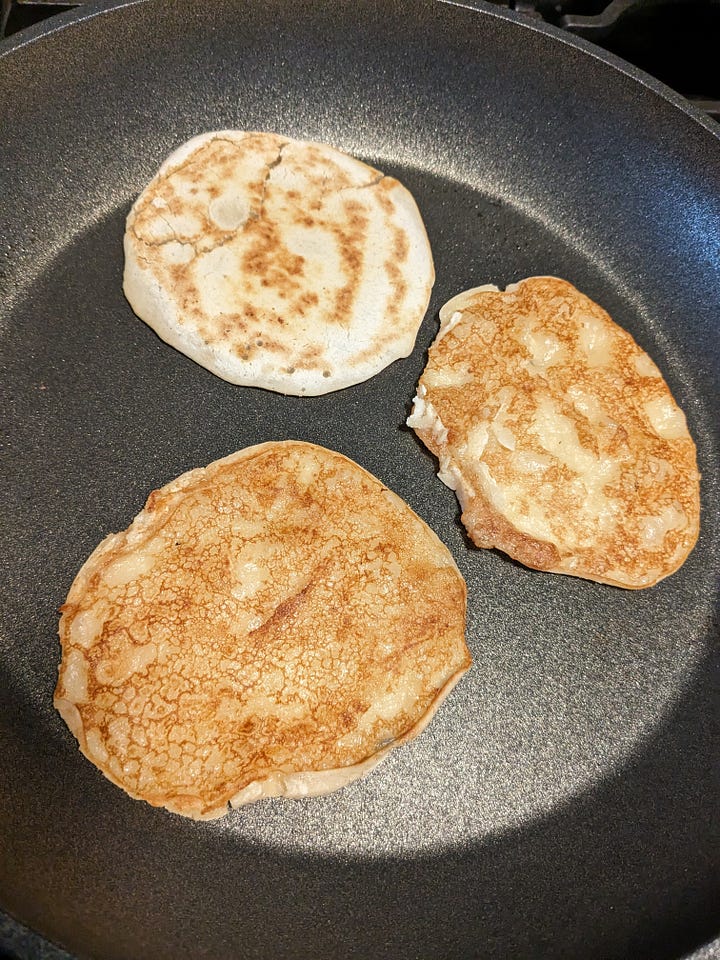
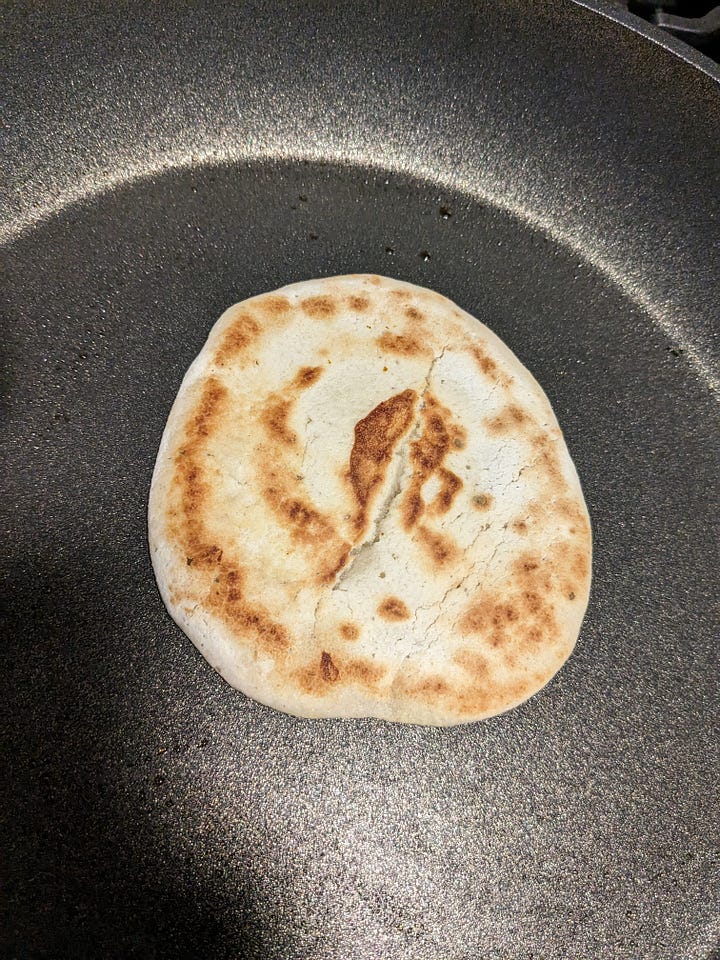
I tried to thicken them up further with additional cassava flour to see if that helped; it did not.
New Cassava Flour
In the interim I found what I think is a “good deal” on one of the fancy brands of cassava flour on Amazon—15 pounds of Otto’s Naturals for $504—so I bought it, given I’m apparently going to keep doing weird cassava experiments for months.
It arrived in what I thought was a huge unmarked bag of white powder that fills its entire large box.
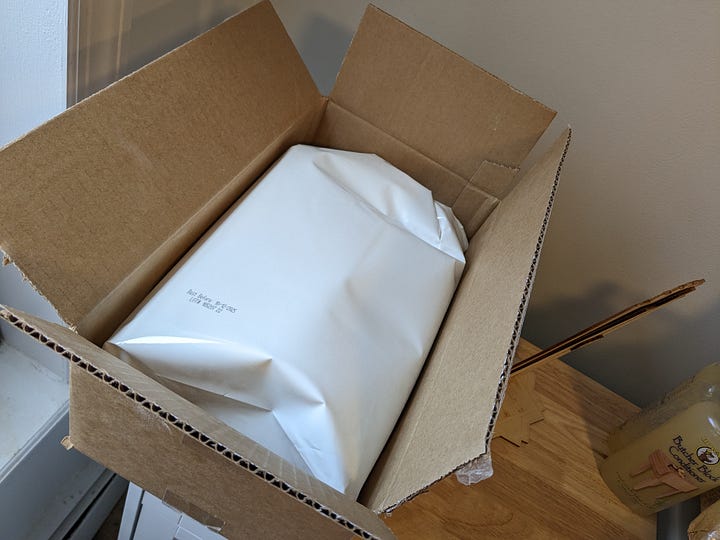
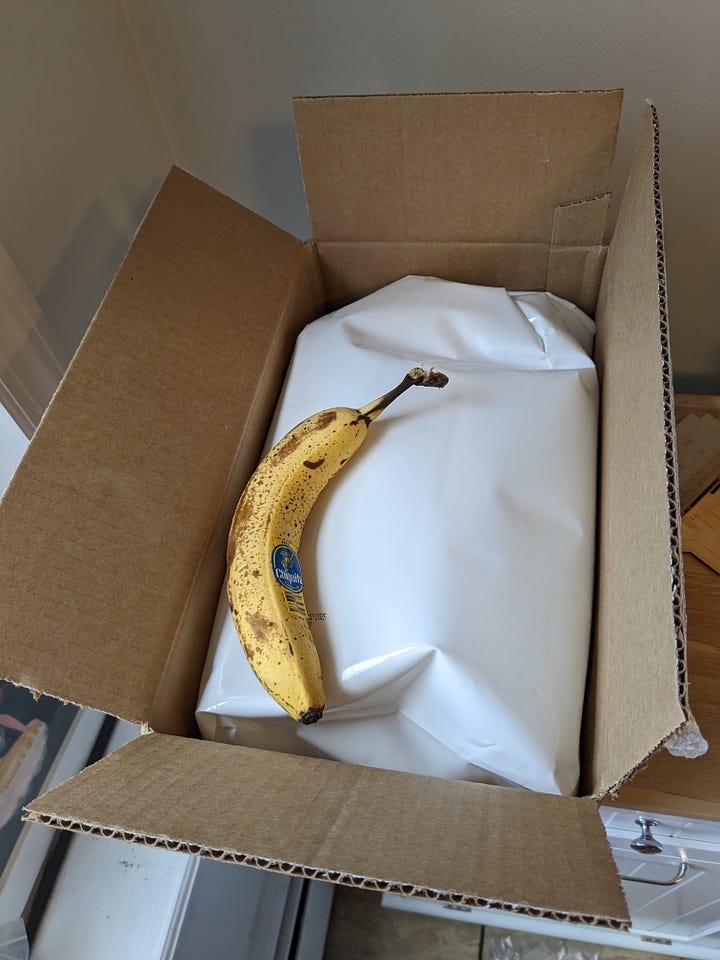
But when I turned it over I saw that it’s technically labeled.
I used this for another run at pancakes.
Cassava Flour Pancake Trials: Take Two
I had the new flour to try out, but I had been considering other reasons for my pancakes’ shortcomings. First, the custardy inside suggested to me that the pancakes weren’t rising enough—they were too dense and wet, but if the inside rose a bit more maybe some crumb would develop and dry them out a bit. I suspected that my baking powder might have been a bit old and inactive—I couldn’t remember when I bought it—so I bought a new container.
I also decided to try and follow the recipe more closely this time, even if that meant more fat than I’d have liked. I just wanted to see whether not enough butter was the problem somehow. I could always reduce it in the next batch for more data.
This batter immediately set up thicker than the previous one had, which suggested the new flour was going to make a difference.
When cooked up, the texture was notably improved (although the “naan-iness” of the flip-side was not fully resolved).
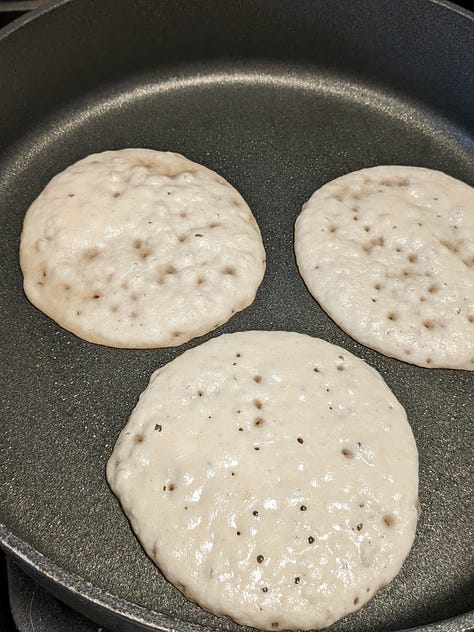
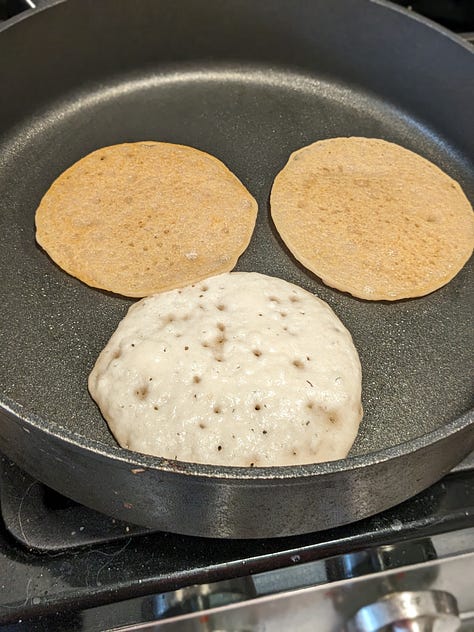

My girlfriend even deigned to eat them, though she said they taste almost like caramel. I had added one tbsp of sugar to the whole recipe to replace any I figured would be in milk, but, perhaps obviously, sucrose had a different effect than lactose. I omitted the sugar in future attempts (though they would probably be good as chocolate chip pancakes with the sugar).
Casabe
If it isn’t clear yet, I have been trying very hard to find easy, processed convenience foods that will fit this diet. I’ve been failing, but I have been trying. In the course of this, I found out that some nearby supermarkets carry casabe, which is essentially a dry cracker that you get when you heat grated cassava in a pan. When I saw the picture of it online I thought I might have seen it before in a refrigerated context, thinking it might have any considerable water content.
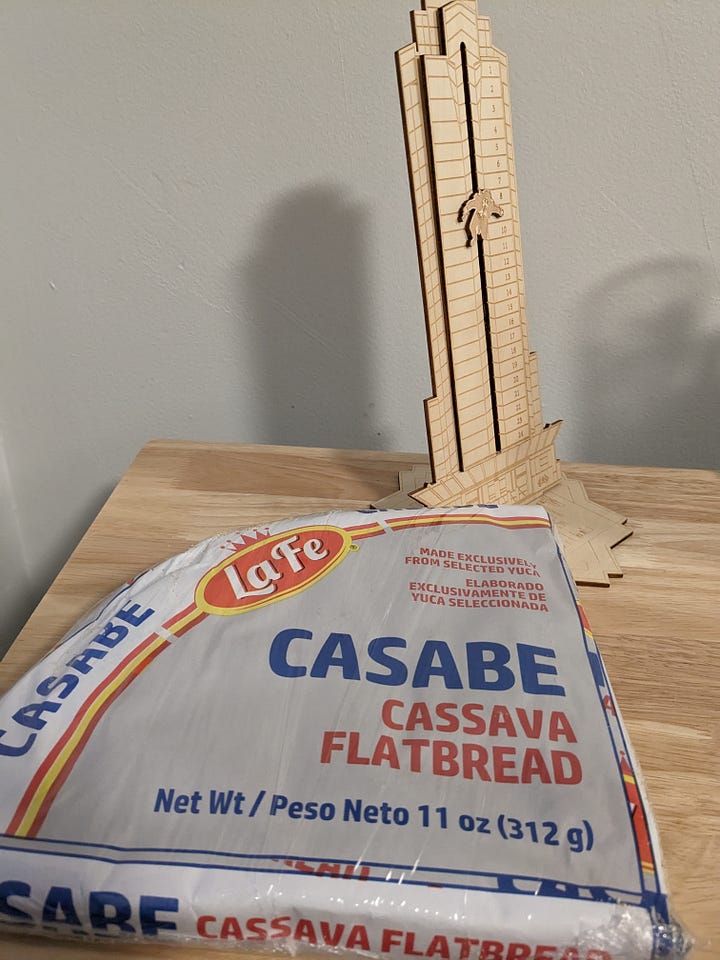

It doesn’t. It is a very dry, crumbly, sort of cardboard-ish cracker that I found sitting on a random shelf. I was actually really hungry when I got back from the grocery store, so I did eat it by itself, and I was like “uhh is this an ‘acquired taste’ thing?” But when I looked it up online afterwards, I found that people usually eat it after adding something wet—even water, apparently, but often coffee, soups, stews, or dips—and maybe after toasting it with oil or something.
Armed with that context, I found it reasonable to dip in soups, or cover in tomato sauce (even making a bullshit “pizza”, baked with leftover tomato sauce and a little bit of cheese). I was still not really a fan and have only gotten through that first 11 ounce package (I had gotten a second package from a different brand on my first go, that I’ve yet to open. It is pretty shelf-stable; when I looked up how to eat it I saw someone on an internet forum refer to it as “Caribbean hardtack”, and, yeah).
On the plus side, it does come with its own gluten-free, low-protein breadcrumbs, as some of it inevitably broke and crumbled during transit. Even if it somehow hadn’t, it would really be extremely easy to crumble and use for that on purpose (and I have added some of the crumbs to GF pasta for texture).
Less-Dumb Yuca Fries
On a comment on my last post, helpful Redditor Gazzamongo blessed my heart with the suggestion that I not actually peel yuca with a peeler. If I’m cutting it into fries anyway, I should just cut it into fry-length sections right away and pull the bark-like peel off at the seam. They are entirely correct:
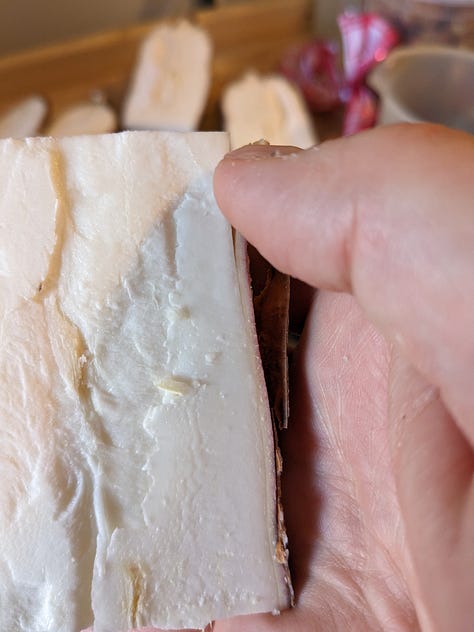
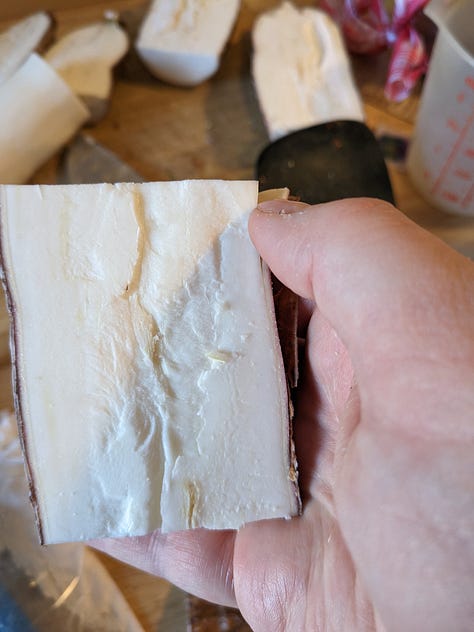
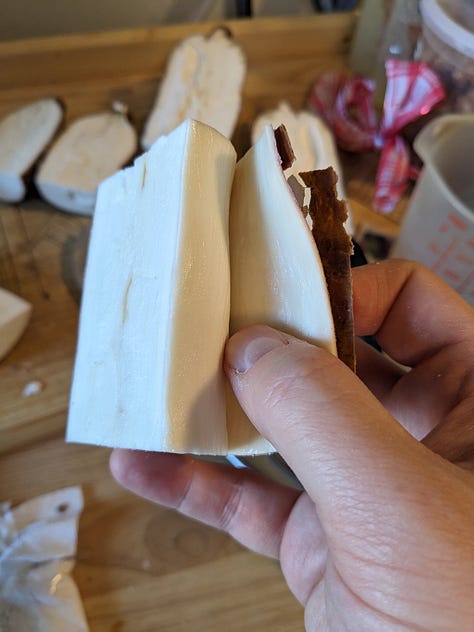
Thanks, Gazzamongo!
Cassava Flour Pancake Trials: Take Three—Satisfaction
While scrolling through the r/saturatedfat subreddit, I saw this comment, in which a user suggests that an egg is necessary for these pancakes to get the structure they need. Searching back to find the comment and link to it now, I realize that it is Brad, the proposer of the Emergence Diet, but at the time I was just like “oh word, that aligns with all the Holiday Baking Championship I’ve been watching lately, I should try that.”
It worked. A batch with one egg and one gelatin egg’s worth of gelatin produces the fluffiest batch yet. I was too busy eating them to take a picture, so I had to take pictures of the ones I made this morning to append here—but I added two tsp of matcha powder to this one, so... they’re green. I also poured these ones with 1/3 cup of batter instead of 1/4, because during the last batch I had made an extra large one with the final bit of batter, and it seemed to fluff up the most. That worked here—though it crowded my pan with 3 of them, making them harder to smoothly flip—they were fluffier still. When I smooth out the batter with the back of a spoon, I think of it like putting a divot in the center of a burger so it doesn’t swell up too much in the middle, and that seems to have a good effect, too.
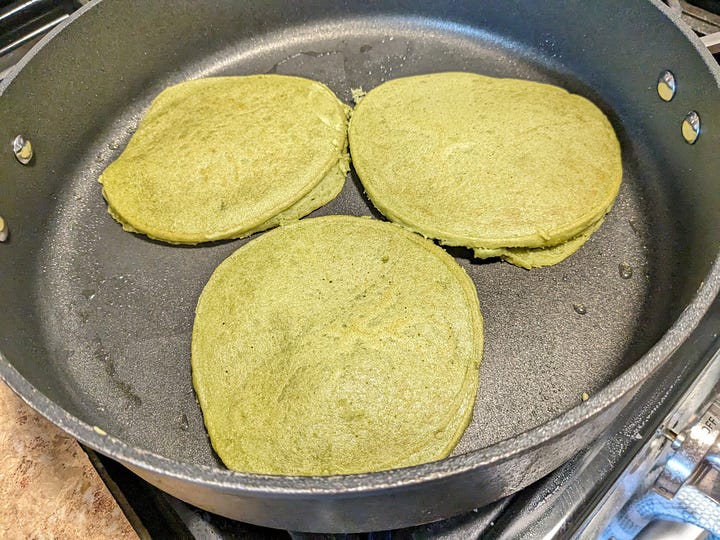
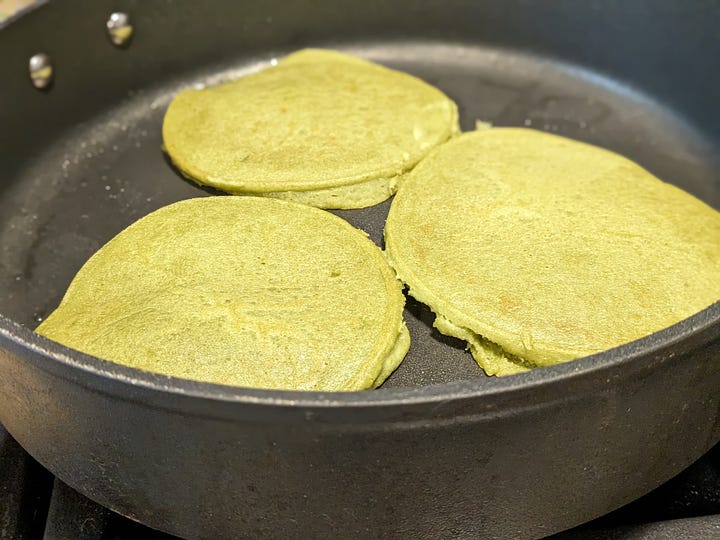
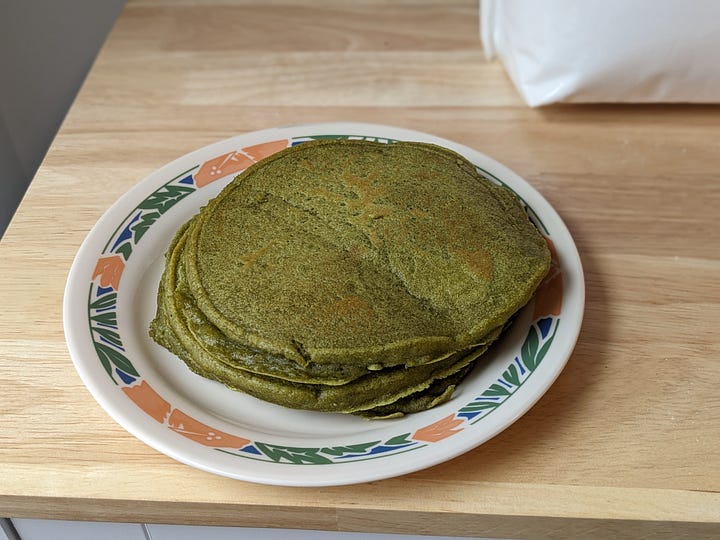

I tried to just mix the gelatin powder in with the dry ingredients (so I could mix up a bunch of ziplock bags of the dry ingredients for easier future breakfasts), but that doesn’t work—the gelatin doesn’t fully dissolve and you get some gritty crystals in the pancake. So I just mixed up the flour, baking powder, and salt into bags and will make the gelatin egg as usual to mix in with them along with the other wet ingredients.
Other Interesting HCLF Foods
I went to some friends’ house to watch the finale of this season of The Amazing Race. They started in Thailand and finished up leaving Ireland, so I decided to make some themed food that I’d be able to eat without feeling like I was cheating super hard on the diet yet again. I made vegetarian Pad woon sen (a glass noodle stir fry), with egg, and vegetarian Shepherd’s pie, with mushrooms. Those both came out great.
I make air fryer fries basically every day by cutting two potatoes up, rinsing and salad spinning them, then tossing them in chili powder, turmeric, garlic powder and pepper, then spraying with a bit of cooking spray, tossing and adding salt last when the air fryer is almost pre-heated (if you add the salt earlier it starts to draw starchy goo back out of the spin-dried potato). 21 minutes at 400 degrees Fahrenheit works for my air fryer.
I’ve also been making mofongo, basically very garlicky mashed plantains. It’s delicious. Will update on those and other efforts in an upcoming post.
Diet Updates
My Diet
My mood and energy remain good on this HCLF low-protein diet, although my compliance has been pretty poor for much of the past month and a half. I have had a number of hardcore cheat days, basically not limiting myself at all for Thanksgiving, a Friendsgiving, Christmas Eve (Feast. Of. The. Seven! FISHES!), Christmas, and New Year’s Eve, all of which I seriously feasted for. I also had a number of other “friend outing” days where I didn’t get anywhere near as low as I’m targeting on protein or fats. I’ve been drinking rather a lot while making merry. I’m basically down 5 pounds over the holiday season, following this diet pretty closely during the day on about 80% of days and sporadically eating a truly insane amount of food in a single day.
The plan is to give the diet itself another serious try for the next few weeks and see if I return to easy weight loss (I basically dropped the five pounds before Thanksgiving and have been maintaining that loss through the rest of the holiday season, bouncing back and forth between three and seven pounds down). That’s because I think the results of a serious attempt at this diet are data worth recording—I have been thinking of it as a “potato diet riff” trial where the riff is that I add anything else I want that doesn’t increase protein/BCAAs or fat beyond that of the potato diet. I’m still not going to be working out for the next few weeks, because I want to test the diet in isolation. (I have a doctor’s appointment for January 30th where I’ll get my cholesterol retested, to see how this way of eating has affected it over two and a half months.) After that, I probably will try to start working out because I feel like I have the energy to do so fairly easily on all these carbs—or, I may switch to testing another diet.
Potato Diet Riff Results
On that note, the first potato diet riff trials are out! In my initial post, I made some testable hypotheses about which riffs would work, if BCAA restriction was the main cause for the potato diet’s success. Amongst them: we would predict potatoes and cream works if the BCAA restriction is critical, and the fat restriction is not. We would not predict a steak and potatoes diet to work at all, if the BCAA restriction is critical.
Expected
Those hypotheses were borne out.
About half of reported participants tried potatoes and dairy, which basically seemed to work about as well as the potato diet itself (8 pounds of weight loss on average, inclusive of one person who lost no weight but included cheese and chocolate and says their waist went down by an inch)5. The two dairy participants who lost the least mentioned cheese specifically (which has much more protein than cream or butter). Two of the three who lost the most seemed to lean toward “mashed potatoes with cream”, and the one of those three remaining just didn’t provide a lot of info, but did say he was inspired by the “ice cream hypothesis”.
(We’d expect people who ate cream and potatoes to get even less protein than those who just eat potatoes, on equivalent calories, as some of their calorie consumption is made up of the very low-protein cream.)
Someone tried steak and potatoes, and only lost two pounds. This is fully expected if the diet works by restricting protein, as the steak undoubtedly provided it in relative abundance.
Unexpected
Nevertheless, there were successful, unguessed riffs whose success does run counter to my expectations! The two highest weight-loss riffs included sources of protein: the greatest loss, of 19.8 pounds, included 100 grams of protein powder from milk, and ketchup; the second greatest weight-loss, of 17.2 pounds, included lentils and butter.
Let’s take the lentils and butter riff first—I had specifically predicted that a rice and beans mono-diet wouldn’t work, because the beans would likely push the protein amounts over the theoretical ceiling I was proposing. Beans have about twice as much protein as white rice or the highest-protein potatoes, per calorie, so if you averaged them out and got half your calories from each, you’d be 50% over the all-potato protein level. But given these results suggest fat doesn’t halt the diet’s effectiveness, I’m not sure what I’d have predicted with the inclusion of butter. The butter should have replaced some of the potato and bean calories, reducing the overall level of protein.
Luckily, this subject gave useful specifics, which SMTM included. The subject used 5 pounds of yellow potatoes to 1 lb of dried lentils in their preparation, with 1/4 cup of butter. That looks like around 1600 calories of potatoes to 1000 calories of lentils, or 8:5 in favor of potatoes. Yellow potatoes are also on the lower-protein end of the spectrum, with less than, e.g., russets. That combination would average out to maybe 40% more protein per 2000 calories than I figured these diets should target. But with the 1/4 cup of butter adding 400 calories, it looks like they averaged that down a bit more, making it more like 20% higher protein than just potatoes. That’s not so far out of the expected range, so I guess it isn’t terribly surprising. It is some evidence that we can raise protein beyond just the “potatoes-only” level, though!
As for the protein powder success, it more fundamentally runs counter to my expectation. Maybe “the potato diet works mainly through protein restriction but has some wiggle room in it” explains the lentils participant, but 100g of additional protein is basically by itself double what I expect the regular potato diet yields, so that data point seems to really challenge the hypothesis. It’s basically the same protein as the pound of steak in the other riff.
Looking into this person’s report, they themselves give an alternate possible explanation. First… they were using jarred potatoes, which are apparently a thing, and they microwaved them and ate them with ketchup. They report not liking potatoes, or the protein powder they were using, saying “personal dislike for potatoes and the unpleasant taste of the protein powder negatively impacted the diet experience.” So maybe they just weren’t eating much, because they were only eating two things they found revulsive…? They also say “For privacy reasons, I’ve omitted a factor that may be important. Please don’t update too strongly on my results,” which is tough (and mysterious). On reflection, I will try to not update too strongly on their results, I suppose, but I am very interested in seeing whether other people use higher-protein riffs successfully. If a number of other people add 100g of protein to their diets and the potato riffs still work, I will think it’s pretty strong evidence that something else about potatoes (potassium? some kind of “anti-SMTM’s-proposed-pollutant” effect?) is causing the results.
There’s also another participant who included “fish for protein” (and a number of other things) in their riff, and lost 8.5 pounds in a month. It’s hard to evaluate how much protein this riff added and update accordingly, as they don’t really say how much fish they were consuming. They mention canned fish; if this is, like, a 5oz can of tuna then it’s only adding 20g of protein, and the inclusion of olive oil, apples, etc., might largely cancel it out.
Also interesting: the margarine and bread riff definitely didn’t work.
Takeaways
It sure looks like a substantial amount of fat (certainly of dairy fat) does not prevent the potato diet from working! If I were starting this diet right now and only interested in weight loss, I would probably just try the mashed potatoes diet. It sounds amazing in a whole lot of ways. I would also maybe have attempted this HCLF diet I’ve been doing with more fat (although, given what initially spurred me to try it was my blood cholesterol levels, perhaps not). So far, I think we’re mostly seeing things in line with my initial low-protein hypothesis, but I’m going to continue doing my diet to add to the evidence, and am excitedly awaiting additional riff data.
I’m beginning to think that, given the mashed potato diet’s apparent supremacy, my weird cassava and plantain experiments will all be useless to the future tubervorous humanity even if protein turns out to be the important driver of the diet’s success, and the sole reason remaining for my continuing the HCLF low-BCAA diet is to get more evidence to confirm or deny the BCAA hypothesis. Though… perhaps a mashed potato, cassava pancake, and mofongo diet would be just as effective, and variety is always nice!
Please let me know your thoughts on any of this! Did you think the potato riff results bore out my proposed “unified theory” BCAA hypothesis? Is there anything I’m missing? Do you wish I’d stop telling you about the weird shit I’m eating and stick to diet theorizing? Comment below!
Cassava was the other potential staple starch that seemed very low in BCAA and suitable to our cause.
or maybe a gluten-free one, for which these recipes also seem well-suited
This enterprise is built on honesty, which compels me to impress upon you that they are not nearly as delicious as pizza with gluten, which is an acknowledged top-tier food.
This is an affiliate link. I figured if I was going to link to an Amazon product I might as well affiliate link it in case anyone actually buys it from here. It took like three steps to sign up, but I now feel slightly gross and can no longer see my reflection in mirrors.
Versus an average of ten pounds on the full-potato diet.




